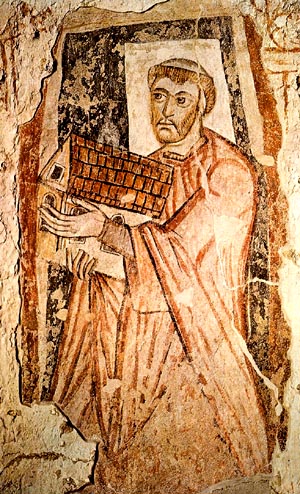Benedict Biscop facts for kids
Benedict Biscop (born around 627, died 690), also known as Biscop Baducing, was an Anglo-Saxon nobleman, monk, and abbot. He started and supported the Monkwearmouth-Jarrow Abbeys. He used to be a close advisor (called a thane) to King Oswiu of Northumbria. Benedict Biscop is famous for the large library he built at Jarrow. He was also the teacher of the well-known scholar, the Venerable Bede. After he died, people honored him as a saint.
Contents
Life of Benedict Biscop
Early Life and Journeys
Benedict Biscop was born around the year 627. He came from a noble family in Northumbria, a kingdom in old England. When he was young, he worked for King Oswiu of Northumbria. He was a wealthy nobleman and had a lot of political influence.
At the age of 25, Benedict decided to leave his old life. He gave up his marriage and family to join the Church. In 653, he made a religious journey (a pilgrimage) to Rome. He traveled with Wilfrid, who later became an important bishop. Benedict returned home soon after this trip.
He made a second trip to Rome in 664 and stayed for about two months. After that, he became a monk on the island of Lérins. Two years later, he agreed to help Theodore, the new Archbishop of Canterbury, travel from Rome to England. Once in Canterbury, Benedict became the leader (abbot) of St Augustine's Abbey. He also traveled to Vienne to collect many books. Biscop made a fourth journey in 679 to get even more books.
Building Monasteries
In 674, Benedict Biscop started building a monastery called Monkwearmouth. King Ecgfrith of Northumbria gave him land near the River Wear. This monastery was dedicated to Saint Peter. It became known as St. Peter's at Monkwearmouth. Benedict wanted his monastery to be a place for both learning and religion.
Benedict brought skilled stonemasons from Francia (modern-day France) to England. They built the monastery using stone. Monkwearmouth was the first stone church in England. Later, Jarrow would be the second. Benedict also brought glassmakers from Francia to make beautiful windows for the church. They even set up a glass workshop there. The monastery was finished within a year. In 678, the Pope sent a letter saying the monastery was free from outside control. Benedict collected many religious items, sacred containers, and decorations. Some he found nearby, while others he bought in Francia and Rome. In 680, Benedict made another trip to Rome. This time, he brought back Abbot John, a skilled singer. Abbot John taught the monks all the church songs exactly as they were sung in St. Peter's Basilica in Rome.
In 682, King Ecgfrith gave Benedict more land for a second monastery. This one was at the mouth of the River Trent at Jarrow. The stained glass for Jarrow came from the same workshop at Monkwearmouth. The opening ceremony for Jarrow Abbey was on April 23, 685. It was named for Saint Paul. When this sister monastery was finished, Benedict made Ceolfrith its abbot. Bede, who was about ten years old, was one of the monks who went with Ceolfrith.
Leading the Monasteries
Benedict wanted to make sure his two monasteries worked together. He made them dependent on each other, so they were treated as one large monastery. He also decided that only one abbot should lead both houses. Benedict himself was the first abbot of Monkwearmouth-Jarrow. He remained the abbot for sixteen years. Together, Monkwearmouth and Jarrow housed about 600 monks.
Benedict's Character and Legacy
The scholar Bede wrote about Benedict Biscop's personality. Benedict was humble and didn't seek attention. He did his daily tasks just like any other monk, even as the abbot. He enjoyed helping the other monks with their duties. This included working in the kitchen, threshing grain, or baking bread. He also liked working in the gardens.
As a leader, he was gentle and kind in keeping order among the monks. He ate all his meals with the other monks and shared their food. Benedict slept in a small room, just like any other monk. As he was dying, he asked all the monks to gather around him so he could say goodbye. He died on March 7, 685. His assistant, Ceolfrith, took over as abbot of both monasteries.
See also
 In Spanish: Benito Biscop para niños
In Spanish: Benito Biscop para niños


